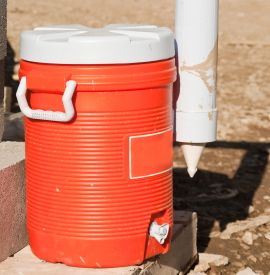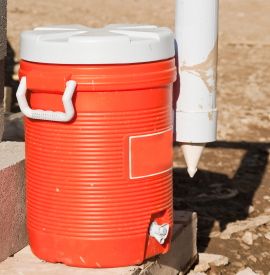 In most jobs, if you have to spend even part of your workday exerting yourself under the hot summer sun, you’re likely to have drinking water nearby. And, if you don’t, you probably won’t be penalized for going to find some. But for many farmworkers in California, the largest agricultural producer in the country, the freedom to hydrate isn’t always so straightforward.
In most jobs, if you have to spend even part of your workday exerting yourself under the hot summer sun, you’re likely to have drinking water nearby. And, if you don’t, you probably won’t be penalized for going to find some. But for many farmworkers in California, the largest agricultural producer in the country, the freedom to hydrate isn’t always so straightforward.
Even as temperatures climb above 90 degrees F, many of the state’s 400,000 farmworkers don’t have access to shade; or the water station is too far from where they are picking a crop, and they have to put off getting a drink. And since farmworkers are so frequently paid on a piece-rate basis rather than hourly, there’s strong incentive to put off that drink, if available at all, for as long as possible.
It’s not that there aren’t laws requiring water and shade (there are), but if you’re a worker on a California farm, you’re not likely to see labor inspectors patrolling the fields, making sure all the rules are being followed and workers are safe, let alone comfortable.
Farmworker advocates have been pushing on the issue for years — public attention to farmworkers and heat safety spiked in 2008, when Maria Isabel Vasquez Jimenez, 17 years old and two months pregnant, died from heat exhaustion she developed while working in California’s grape vineyards.
Two years earlier, her employer had received citations for exposing workers to heatstroke and not training them on heat safety, and a fine had been issued. But it was never collected, and the California Occupational Safety and Health Administration (Cal/OSHA) did no follow-up inspections of the company.
Now, nearly four years later, little has changed about the conditions that led to her death, nor the poorly enforced laws that enable those conditions.
Which is where the Farm Worker Safety Act of 2012 enters the picture. The law would hold growers and labor contractors jointly liable if workers are not provided adequate shade and water. What happened to Maria Jimenez was an extreme case; death from heat illness is relatively rare. But the legislation is as much about improving the quality of life for workers as it is about preventing unnecessary deaths.
Farmworkers are not only vulnerable to dehydration and heatstroke, but also to other health problems like urinary and kidney infections, according to the National Center for Farmworker Health. And if a worker happens to have diabetes, or another chronic illness, it can compound the risks that come with heat exhaustion generally.
Some crops are better than others. “When people are working, picking cherries or picking apricots or pears,” said Luis Magaña, director of the Organization of Farm Workers of California, “at least they have shade provided by the trees. And they have a chance to rest under the trees.”
But crops that grow in low-lying rows — asparagus, tomatoes, and grapes, for example — leave workers entirely dependent on shade their employers provide. (And it may not matter if the asparagus you’re eating is organic or not.)
Of course, if there’s no drinking water available, the situation is ultimately the same — shade or no shade. It doesn’t take a medical professional to know that prolonged physical exertion in extreme heat without proper hydration is asking for trouble.
Existing regulations allow farmworkers to file a complaint with Cal/OSHA if they are not provided adequate water or shade, and require the agency to send an inspector out within three days. But with about 200 labor inspectors to cover the state’s estimated 35,000 farms, Cal/OSHA does not often meet that requirement, according to farm labor advocates.
“Last year alone, UFW filed 75 complaints. In over two-thirds of those cases, Cal/OSHA didn’t send someone at all, let alone within three days,” said Giev Kashkooli, strategic campaigns director for United Farm Workers (UFW). Cal/OSHA would not confirm or deny the number of complaints filed.
Magaña said that generally, inspections at California farms did increase for about a year after Maria Jimenez’s death, because there was so much public attention on the issue. “But now, without the same publicity,” he said, “Cal/OSHA is not regularly visiting these places. Sometimes, but not very regularly.”
He added that when inspectors do show up, a farmer or contractor can often see them coming, and can use that time to prepare. He also said that because the inspections are so sporadic, employers can say the workers will be moving to another field soon, and shade will be provided there. “They can manipulate the situation very easily,” he said.
When inspectors do find situations to write up, it rarely amounts to much. “Fines are routinely marked down and often never collected,” Kashkooli said, adding that there’s no recourse for workers when Cal/OSHA does not come through for them.
UFW says that, using statistics from Cal/OSHA, at least a third of the farms they inspect are out of compliance with the heat illness regulation. “This means using conservative numbers for the number of farmworkers in the state, at least 140,000 farmworkers do not have basic things like shade or water every day they go to work,” said Kashkooli, adding that the law would “deliver fair consequences for the employers who choose to put farmworker lives at risk by not providing water and shade.”
The Farm Worker Safety Act would also establish a private right of action so that farmworkers can take their employers to court if Cal/OSHA does not sufficiently respond to their complaints — meaning workers could sidestep Cal/OSHA, which right now is their last resort for making sure the laws are enforced. Under the proposed legislation, a worker can take a problem up directly with his employer, rather than wait for Cal/OSHA to act, or more likely, according to UFW, to not act.
Since there’s effectively no punishment for breaking the rules the way they stand now, there’s no incentive for following them.
What this all adds up to for the workers who produce so much of our food is a pretty bleak situation: Aside from the health risks, there are the psychological effects that come both with heat stress and with being treated so poorly on a daily basis.
There are some advocates who think better enforcement of existing laws, in the form of more inspections, is what’s necessary — not new legislation. Gail Wadsworth, executive director of the California Institute for Rural Studies, is one of them.
“Farmers are well aware of what they’re required to do, and the majority of farmers are meeting those regulations. But there’s always going to be outliers,” she says. “Enforcement, I think, is a better solution if the state legislature could be motivated somehow to increase funding to Cal/OSHA for inspections and follow-up.”
Wadsworth is skeptical, but not opposed to the proposed law. She’d like to see it effectively improve conditions for farmworkers, but she also believes those conditions are emblematic of a much larger problem: the fact that farmworkers have little power under the law and in our society generally. That they are treated so often “as tools rather than as people,” she says.
“This is a complaint we hear consistently: ‘We’re looked at as being just another tool in the field.'”
As some advocates see it, the Farm Worker Safety Act, if successful, might begin to change that.



